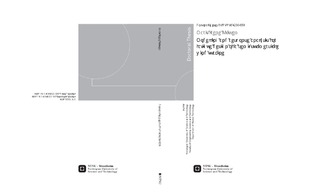| dc.contributor.author | Kvittem, Marit Irene | nb_NO |
| dc.date.accessioned | 2014-12-19T12:13:22Z | |
| dc.date.available | 2014-12-19T12:13:22Z | |
| dc.date.created | 2014-12-10 | nb_NO |
| dc.date.issued | 2014 | nb_NO |
| dc.identifier | 770542 | nb_NO |
| dc.identifier.isbn | 978-82-326-0586-6 (printed version) | nb_NO |
| dc.identifier.isbn | 978-82-326-0587-3 (electronic version) | nb_NO |
| dc.identifier.uri | http://hdl.handle.net/11250/239262 | |
| dc.description.abstract | Offshore wind is seen as part of the solution for reducing the world’s dependency on nonrenewable sources with CO2 intensive production processes. Developing wind turbines that float will enable us to harness wind in deep waters, where the winds are strong and less turbulent than over land. It also means that wind farms can be installed in sites where there are fewer conflicts of interest than onshore. Both wind turbines and floating platforms are well known technologies, but combining them can introduce unexpected interaction effects. A floating wind turbine will experience large loads from wind, waves and rotating blades. These loads will be influenced by each other to a larger extent than for fixed wind turbines, and the interaction needs to be considered in order to predict the loads accurately. By coupling well known aero- servoelastic and hydro-elastic codes, which was done as a part of this thesis, the interaction effects could be accounted for. The large, fluctuating loads experienced by a floating wind turbine will cause fatigue damage to the structure, and could be an important design driver. Accurately predicting the fatigue life requires simulating a large number of load cases, and it also requires long simulation durations due to slowly varying loads and stochastic uncertainty. This thesis focuses on methods to reduce the simulation time for fatigue life prediction. Using a catenary moored, three-column semi-submersible wind turbine with the NREL 5MW turbine mounted on one of the columns as a case study, the following aspects of FWT fatigue analysis were investigated: Frequency domain versus time domain analysis. Simulation length, number of seeds and bin sizes for selection of environmental conditions. Misaligned wind and wave directions. Morison versus potential theory for hydrodynamic modelling. A frequency domain method for finding the variance spectrum for tower base bending moment in moderate environmental was developed and compared to results from coupled time domain simulations. The results showed that applying a frequency domain method including an approximation of dynamic excitation of the first flexible bending mode of the tower and blades, could predict bending moment standard deviations with reasonable accuracy. The necessary simulation length can be up to 3-6 hours in extreme value analysis for compliant offshore platforms, but a long term fatigue analysis showed that reasonable accuracy can be obtained using shorter simulation lengths and fewer random seeds. It was also indicated that assuming wind and waves to come from the same direction will give a conservative fatigue estimate In all the case studies, fatigue was calculated for nominal stress. As the purpose was to study the simulation parameters affecting fatigue life, and not the fatigue life itself, it was assumed that the hot-spot stress amplitudes for the different load components are proportional to the nominal stress. Proper representation of wave loads could be obtained using Morison’s equation, provided that the inertial coefficients were determined separately for each sea state. | nb_NO |
| dc.language | eng | nb_NO |
| dc.publisher | NTNU | nb_NO |
| dc.relation.ispartofseries | Doktoravhandlinger ved NTNU, 1503-8181; 2014:337 | nb_NO |
| dc.relation.haspart | Paper 1:
Effects of Hydrodynamic Modelling in Fully Coupled Simulations of a Semi-Submersible Wind Turbine. Energy Procedia 2012 ;Volum 24. s. 351-362
<a href="http://dx.doi.org/10.1016/j.egypro.2012.06.118" target="_blank"> http://dx.doi.org/ 10.1016/j.egypro.2012.06.118</a>
The article in is reprinted with kind permission from Elsevier, www.sciencedirect.com | |
| dc.relation.haspart | Paper 2:
Time domain analysis procedures for fatigue assessment of a semi-submersible wind turbine. Marine Structures 2015 ;Volum 40. s. 38-59
The manuscript is accepted and published in Marine Structures www.sciencedirect.com
<a href="http://dx.doi.org/10.1016/j.marstruc.2014.10.009" target="_blank"> http://dx.doi.org/ 10.1016/j.marstruc.2014.10.009</a> | |
| dc.relation.haspart | Paper 3:
Bachynski, Erin Elizabeth; Kvittem, Marit Irene; Luan, Chenyu; Moan, Torgeir.
Wind-wave misalignment effects on floating wind turbines: motions and tower load effects. Journal of Offshore Mechanics and Arctic Engineering-Transactions of The Asme 2014 ;Volum 136.(4) s.
Is not included due to copyright.
Available at: <a href="http:// 10.1115/1.4028028" target="_blank"> http://dx.doi.org/ 10.1115/1.4028028</a> | |
| dc.relation.haspart | Paper 4:
Frequency versus time domain fatigue analysis of a Semisubmersible wind turbine tower. Journal of Offshore Mechanics and Arctic Engineering-Transactions of The Asme 2015 ;Volum 137.(1) s.
Is not included due to copyright.
available at:
<a href="http://dx.doi.org/10.1115/1.4028340 " target="_blank"> http://dx.doi.org/10.1115/1.4028340 </a> | |
| dc.title | Modelling and response analysis for fatigue design of a semi-submersible wind turbine | nb_NO |
| dc.type | Doctoral thesis | nb_NO |
| dc.contributor.department | Norges teknisk-naturvitenskapelige universitet, Fakultet for ingeniørvitenskap og teknologi, Institutt for marin teknikk | nb_NO |
| dc.description.degree | PhD i marin teknikk | nb_NO |
| dc.description.degree | PhD in Marine Technology | en_GB |

